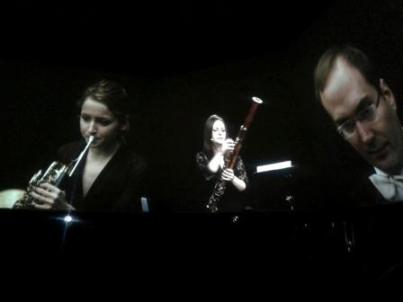And with the sound of the orchestral instruments tuning, the Universe of Sound was launched in Canterbury last night. Welcoming speeches from various dignitaries, including Richard Slaney, head of digital at the Philharmonia, and the Mayor of Canterbury gave way to a dimming of the lights and the familiar sound of the orchestra tuning up, before launching into the ominous ostinato with which ‘Mars’ from The Planets suite stirs into life.

Screen time
Watching the efforts of the different sections of the orchestra on large screens around the hall, you gain a real sense of the physical effort involved in playing as part of the orchestra. Standing in the violin section during ‘Mercury,’ you really felt the hardship of the instrumentalists working away at those scurrying passages. At various stages, the installation will have members of the orchestra playing live as part of their virtual orchestral section; bring your instrument, and you can also sit at an unoccupied orchestral desk and play along too.

Desk job…
As you walk round the installation, you also experience the sonic nature of what it means to play amidst the different orchestral sections from carefully laid-out speakers; fragmented, exposed, not always able clearly to hear the solo line that might be occurring over in the flute; the brittleness of the reed instruments, the weighty chords of the brass, the rasp of bow on string; it makes you appreciate anew that magical alchemy that occurs when a good acoustic environment transforms all these disparate sections, moulding them as if magically into an homogenous sound. From your comfortable seat in the audience, the ensemble appears a perfectly-unified Rolls Royce; up close, it’s hard work, yet delivered with consummate skill by these professional musicians. An oboe solo line arcs lyrically and effortlessly overhead; from out of nowhere, a nerveless principal horn delivers exquisitely-crafted phrases.

Strings on screen
There are also some wonderfully human touches that display the humanity of instrumental playing; brass players empty the water out of their instruments, or blow silently through their instrument shortly before playing; woodwind players check their mouthpiece. It’s a reminder of the fact that music like this is a profoundly human experience, performed by real people demonstrating consummate skill and craft on their instruments.

Making it look effortless:principal bassoon
The percussion section, relegated to a Portakabin outside the hall, offers the most fun, the opportunity to try your hand at playing a variety of instruments, including a tam-tam, bass drum or mark tree, under the guidance of members of the Philharmonia. This is the part of the installation that children are really going to enjoy… There’s also a conducting pod, where you can try your hand at directing the performance, guided by on-screen diagrams of the beat-patterns which monitor your performance in a sort of ‘Just Dance’ experience.
This is only the second outing for the whole project outside of London. After its Canterbury residence, the installation moves to Birmingham. The experience offers insights into, and an appreciation of, orchestral playing and the act of music-making, both to seasoned musical visitors as well as to those coming to orchestral music for the first time, to adults and to children alike. The installation at Augustine House is free, and runs until 12 May.
You can watch the footage from BBC South East’s coverage online here.



 Posted by Daniel Harding
Posted by Daniel Harding 



